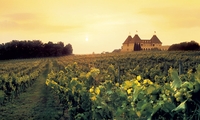I’ve been writing about wine for 16 years now, and made my 1,000th site visit to a wine producer last week, so you might get the idea that all of this is getting a little stale. After all, if you turn over enough rocks, sooner or later you’ll cease to be surprised what you find beneath them. Right?
Well, that may happen to me someday, but the day seems pretty distant based on what I encountered in France’s Loire Valley last week. I’ve been to the Loire twice before, though only briefly on a side-trip to Sancerre in the first instance, along with a second trip that was truncated by a nasty case of food poisoning. Still, I love Loire wines, and taste a lot of them here in the States, so it wasn’t likely that I’d find anything especially surprising, right?
week. I’ve been to the Loire twice before, though only briefly on a side-trip to Sancerre in the first instance, along with a second trip that was truncated by a nasty case of food poisoning. Still, I love Loire wines, and taste a lot of them here in the States, so it wasn’t likely that I’d find anything especially surprising, right?
Wrong. Really, seriously bloody wrong. I’ll devote my November WRO column to revelations from my week in the Loire (which followed the river from Muscadet country near the Atlantic all the way to Sancerre in central France), but I need to recount a case in point from the trip’s first site visit.
That first stop was a visit with André-Michel Brégon in the little town of  Gorges in the Muscadet district. I knew Brégon’s wines more by reputation than experience, and they have a very good reputation, but still: We’re talking Muscadet here, not Montrachet. Muscadet can be a very nice little wine, and it definitely has its role. That role is limited but not unimportant, namely, as an accompaniment to fresh, raw oysters, which are for me objects of quasi-religious culinary reverence.
Gorges in the Muscadet district. I knew Brégon’s wines more by reputation than experience, and they have a very good reputation, but still: We’re talking Muscadet here, not Montrachet. Muscadet can be a very nice little wine, and it definitely has its role. That role is limited but not unimportant, namely, as an accompaniment to fresh, raw oysters, which are for me objects of quasi-religious culinary reverence.
But again, we’re talking Muscadet here, which means a simple little wine that is best slurped with those oysters when it is at its youngest and freshest, but then forgotten in favor of more serious stuff. Right?
Wrong again, though it took me a while to catch on. The first wine presented by the affable, slightly eccentric-seeming Brégon was from 2008, but it was a tank sample because he hasn’t even bottled the wine yet. Since the facility was a glorified garage that looks rather worse for years of wear, I was starting to think that this could be a very long morning. But the 2008 was very promising, and the bottled 2007 better still–vindicating Brégon’s approach–so things were looking up.
The 2006 continued the ascent, and the 2004 was even better, so my preconceptions were starting to crumble. The 2003 should have been dead as a doornail from that famously hot year, but it was amazingly fresh after spending a mind-boggling 45 months resting on its fine lees before bottling. The 2000 was delicious, and two different bottlings from 1999 were both terrific. I went slack-jawed when encountering a 1996 that showed no color change and no aromatic oxidation at all, but that had to be an anomaly stemming form the amazing 1996 vintage. Right?
Wrong yet again. The 1995 was fresh and delicious, and my note on the 1993 enthuses that these wines are somehow armored against the  deleterious effects of oxygen. But Brégon wasn’t done taking me to school, as the 20 year-old 1989 showed the most exciting aromas of the entire lineup, including notes of lemon curd, apricots, mangoes, toasted nuts and caramel. And all of this out of a bottle that had been sealed with a crumbly cork that made André-Michel scowl with disapproval.
deleterious effects of oxygen. But Brégon wasn’t done taking me to school, as the 20 year-old 1989 showed the most exciting aromas of the entire lineup, including notes of lemon curd, apricots, mangoes, toasted nuts and caramel. And all of this out of a bottle that had been sealed with a crumbly cork that made André-Michel scowl with disapproval.
The upshot of all of this is that the world of wine is an endless mine of surprises and wonders, and the Loire Valley is a particularly rich vein for those interested in digging them out. My intention is to keep digging at every chance I get.
1
